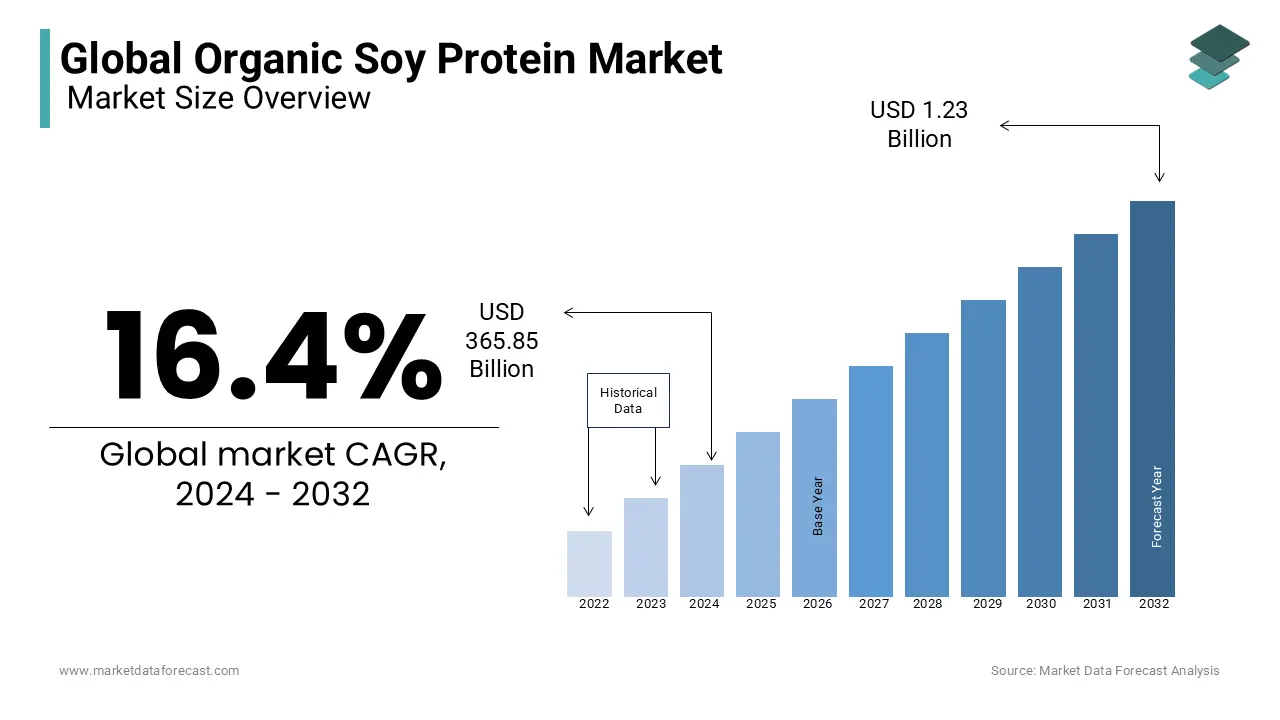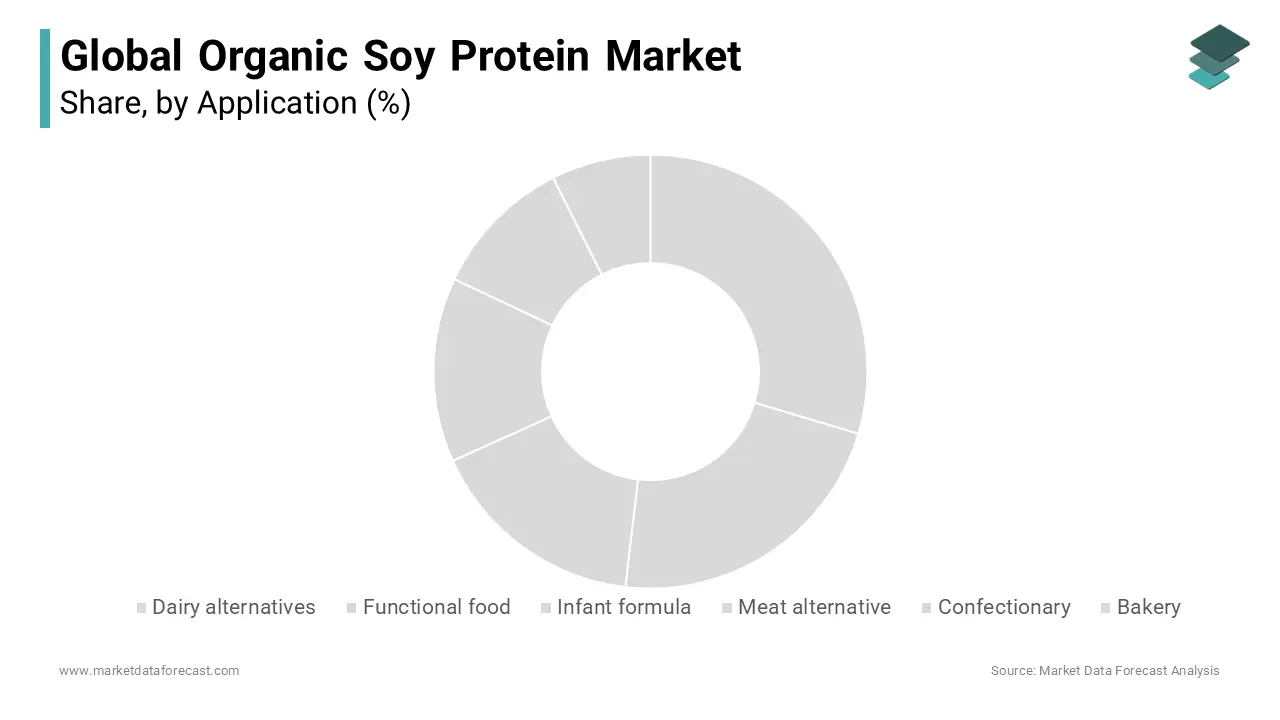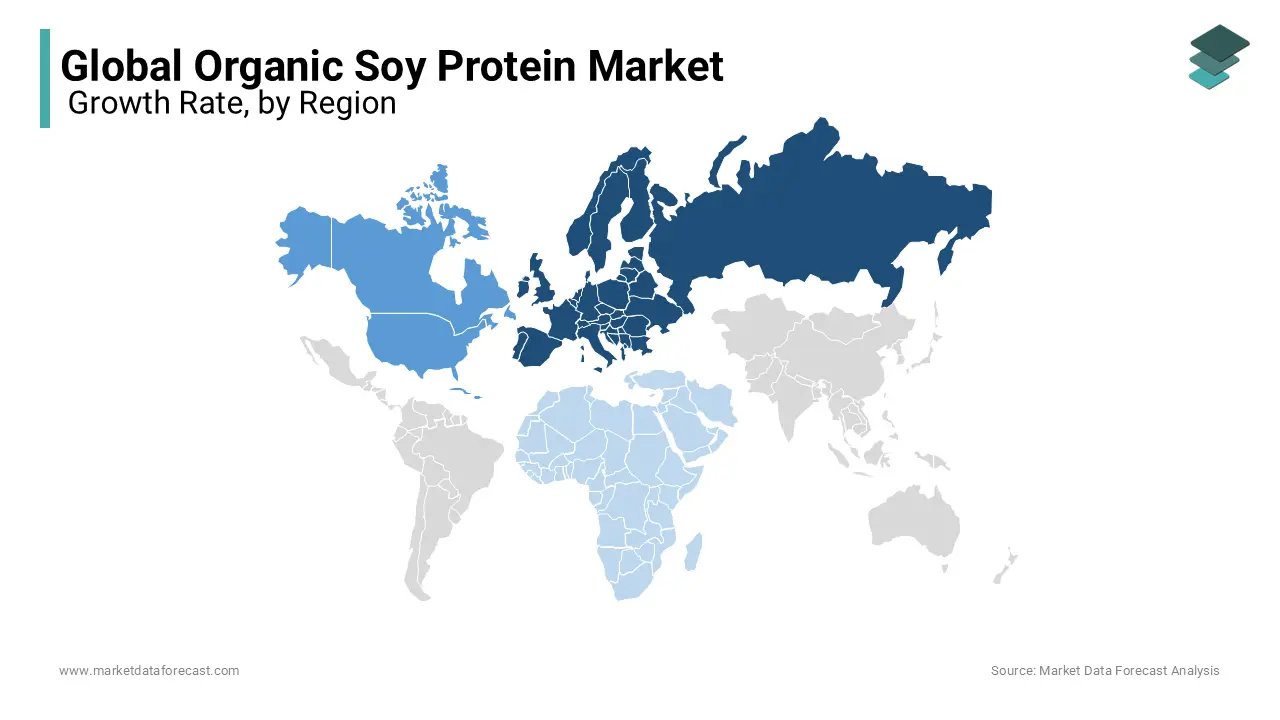Global Organic Soy Protein Market Size, Share, Trends & Growth Forecast Report - Segmented By Application (Dairy Alternatives, Functional Food, Infant Formula, Meat Alternative, Confectionary, Bakery, Others), Form (Powder, Concentrated, Isolated), State (Liquid, Dry), And Region (North America, Europe, APAC, Latin America, Middle East And Africa) – Industry Analysis From 2025 To 2033
Global Organic Soy Protein Market Size
The global organic soy protein market size is expected to be worth USD 365.82 million in 2024 and is anticipated to be worth USD 1.43 billion by 2033 from USD 425.81 million In 2025, growing at a CAGR of 16.40% during the forecast period. With the increasing advantages of soy products, the global organic soy protein market is touted to accelerate with a notable percentage.

The protein extracted from soy without any chemical interference is considered organic soy protein. Soy is ground into a meal that does not contain fat or shell to make soy protein. Soy protein isolate contains approximately 90-95% protein and is sold in powder form, rich in protein and low in carbohydrates. You can also add additional nutrients to improve nutritional value, texture, and flavor. Soy protein provides all the amino acids necessary for healthy growth. Organic soy protein is mainly used for its functional effect and nutritional properties, mainly under normal dietary intake. Well-processed soy protein ingredients are considered to be healthy for humans. Soy protein is used in human food in a variety of ways, including baby food, wheat flour, isolates and protein concentrates, and organized fibers.
MARKET DRIVERS
Due to the rise in the intake of functional and healthy foods, the global soy protein market is foreseen to develop in a considerable way in the coming days.
Also, the growth in several end-use industries, like bakery and confectionery, alternative dairy and meat products, and functional foods, is determined to fuel the development of the organic global soy protein business in the estimated time. The main factors that are expected to increase the demand for organic soy protein products over the forecast period are the health benefits of soy protein, lifestyle changes, and mass consumption of soy protein due to a growing middle-class population. The growing trend in nutrition and healthy diets coupled with the growing health-conscious population in developing countries is estimated to drive the market for organic soy protein for an estimated period. Also, as the demand for protein-rich foods increases in developed countries and the consumption of meat substitutes increases, this organic soy protein market is assumed to progress in the future. As awareness of the various health benefits of soy protein increases, the expansion of the organic soy protein market worldwide is likely to accelerate. The soybean dairy trend is attracting global attention and is foreseen to stimulate market growth.
Increasing consumer awareness of the health benefits of organic foods is a major driver of growth for the organic soy protein market worldwide. There are various forms and types of organic soy protein, and without GMO sweeteners and ingredients or preservatives, growth in the global organic soy protein market is expected to accelerate. The adoption of vegan foods consisting of soy protein as an alternative to meat and dairy products is presumed to contribute to the growth of the global organic soy protein market. Soy protein products are cheaper than other similar products. This can promote sales and consumption. Soy protein is a complete source of protein for the human body and contains amino acids. The organic soy protein market finds increased adoption in the vegan population as it meets their urge for protein. Organic soy protein also has the needs of people with chronic disease, diabetes, and obesity. The rising popularity of organic products will support the expansion of this market. Increased physician recommendations for healthy eating habits and increased consumer awareness of the side effects of eating unhealthy foods are driving demand for organic soy protein. The demand for these products is also increasing from consumers who cannot tolerate lactose and cannot have milk and dairy products. For the development of innovative and profitable organic products, technological advances and increased R&D activities by major players are deemed to create new revenue opportunities for players operating in target markets during the outlook period. In addition, as merger and acquisition activities expand between regional and international companies, it is expected to support further sales growth in the global organic soy protein market.
Increased health awareness among consumers is expected to increase demand for the organic soy protein market in the future.
MARKET RESTRAINTS
The availability of non-organic soy protein threatens the market. This will limit the growth of the market. Along with that, some people are allergic to soy or high protein consumption. These two factors serve to inhibit the growth of the global organic soy protein market.
REPORT COVERAGE
|
REPORT METRIC |
DETAILS |
|
Market Size Available |
2024 to 2033 |
|
Base Year |
2024 |
|
Forecast Period |
2025 to 2033 |
|
CAGR |
16.4% |
|
Segments Covered |
By Application, Form, State, & Region |
|
Various Analyses Covered |
Global, Regional and Country Level Analysis; Segment-Level Analysis; DROC; PESTLE Analysis; Porter’s Five Forces Analysis; Competitive Landscape; Analyst Overview of Investment Opportunities |
|
Regions Covered |
North America, Europe, APAC, Latin America, Middle East & Africa |
|
Market Leaders Profiled |
Burcon NutraScience, Harvest Innovations, Armor Proteins, World Food Processing, George Weston Foods, ADM, Devansoy Inc, Kellogg Company, The Scoular Company, Omega Protein Corporation, SunOpta Inc, MGP Ingredients, Dupont and Bunge Alimentos S.A. |
SEGMENTAL ANALYSIS
Global Organic Soy Protein Market Analysis By Application

The dairy alternatives segment is leading with the largest share of the organic soy protein market. Dairy products are highly nutritional and improve overall health. Where the rising incidences of lactose intolerance-related issues are enhancing the need to launch various plant-based proteins in dairy products. According to some studies, more than 40% of people are completely based on plant-based derivatives.
The infant formula segment is all set to hit the highest CAGR by the end of the forecast period. Stringent rules and regulations by the government to promote high-quality products for the newborn are more likely to enhance the growth rate of the market. It is highly important to provide sufficient nutrient-balanced milk for the infants. Therefore, the launch of formula milk using various technologies with the required nutritional value to improve well-being is solely to leverage the growth rate of the market.
Global Organic Soy Protein Market Analysis By Form
The powder segment holds the dominant share of the market. This form of organic soy protein is effective and convenient to use in any kind of food product. Protein is highly important to boost immunity and eventually fight many diseases. The number of rising fitness enthusiasts and their prevalence of consuming high protein will eventually boost the growth rate of the market. Soy protein is 90% of protein that is helpful to lose weight or gain muscle and others.
The concentrated segment is projected to have a significant growth rate in the market. This form is highly used in meat and poultry products. These products tend to improve nutritional values, and they have gained huge popularity among people in recent times.
Global Organic Soy Protein Market Analysis By State
The dry segment is leading with the dominant share of the market, whereas the liquid segment will eventually hit the CAGR by the end of the forecast period. The dry organic soy protein is used in many food products which is majorly propelling the growth rate of the market.
REGIONAL ANALYSIS

By region, Europe has the largest number of companies in the bakery and confectionery industry, with a significant market share in terms of sales. North America is anticipated to be the second-largest market for this protein. These two regions are expected to be an important source of income for the market, as the demand for organic soy protein continues to increase due to the increasing demand for various end-uses. Asia-Pacific is another important regional organic soy protein market, with significant growth anticipated during the projection period. The growth of the Asia Pacific organic soy protein market will be driven by high demand for confectionery products such as chewing gum and chocolate. Due to the rapid growth of urban life, countries in this region have become more health-conscious and, more recently, are focusing on healthy and nutritious eating habits. This trend also affected India and China, making it the fastest-growing organic soy protein market in the Asia-Pacific area. However, Europe dominates the global market, followed by North America on the basis of the market size. The Latin American market for organic soy protein is expected to be boosted by the massive consumption of meat substitutes and functional foods. As consumer awareness of the benefits of soy products increases, the market for organic soy protein in the Middle East and Africa is likely to accelerate in the future.
KEY MARKET PLAYERS
Burcon NutraScience, Harvest Innovations, Armor Proteins, World Food Processing, George Weston Foods, ADM, Devansoy Inc, Kellogg Company, The Scoular Company, Omega Protein Corporation, SunOpta Inc, MGP Ingredients, Dupont and Bunge Alimentos S.A. are some of the leading players in the global organic soy protein market.
RECENT HAPPENINGS IN THE MARKET
In August 2019, Smithfield Foods launched a new soy-based product under a pure farmland brand that includes hamburgers, dumplings, and breakfast patties.
DETAILED SEGMENTATION OF THE GLOBAL ORGANIC SOY PROTEIN MARKET INCLUDED IN THIS REPORT
This research report on the global organic soy protein market has been segmented and sub-segmented based on application, form, state, and region.
By Application
- Dairy alternatives
- Functional food
- Infant formula
- Meat alternative
- Confectionary
- Bakery
- Others
By Form
- Powder
- Concentrated
- Isolated
By State
- Liquid
- Dry
By Region
- North America
- Europe
- Asia-Pacific
- South America
- Middle East & Africa
Frequently Asked Questions
1. What nutritional benefits does organic soy protein offer?
Organic soy protein is rich in essential amino acids, making it a complete protein source. It also contains vitamins, minerals, and antioxidants. Additionally, it is often low in saturated fat and cholesterol.
2. How is organic soy protein used in food products?
Organic soy protein is used in various food products, including plant-based meat alternatives, protein bars, shakes, dairy alternatives, and baked goods. Its versatility makes it a popular choice in the food industry.
3. How is organic soy protein produced?
Organic soy protein is typically produced by isolating protein from organic soybeans through extraction, defatting, and purification processes. These methods help retain the nutritional integrity of the protein while meeting organic standards.
Related Reports
Access the study in MULTIPLE FORMATS
Purchase options starting from $ 2500
Didn’t find what you’re looking for?
TALK TO OUR ANALYST TEAM
Need something within your budget?
NO WORRIES! WE GOT YOU COVERED!
Call us on: +1 888 702 9696 (U.S Toll Free)
Write to us: [email protected]